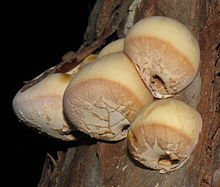Source: Wikipedia
| Cryptoporus volvatus | |
|---|---|

| |
| Scientific classification | |
| Kingdom: | |
| Division: | |
| Class: | |
| Order: | |
| Family: | |
| Genus: | |
| Species: | C. volvatus
|
| Binomial name | |
| Cryptoporus volvatus | |
| Synonyms | |
| |
Cryptoporus volvatus, commonly known as the veiled polypore or cryptic globe fungus,[1] is a polypore fungus that decomposes the rotting sapwood of conifers. It is an after effect of attack by the pine bark beetle.[2] The fungus was originally described by American mycologist Charles Horton Peck in 1875 as Polyporus volvatus.[3] Cornelius Lott Shear transferred it to the genus Cryptoporus in 1902.[4] The species is inedible.[5]
The fruiting body is 2–6 across, and cream or tan in color.[6] A hole is either torn by insects or a tear appears on the underside.[6] The spores are pinkish.[6]
References[edit]
| Cryptoporus volvatus | |
|---|---|
| Pores on hymenium | |
| No distinct cap | |
| Hymenium attachment is irregular or not applicable | |
| Lacks a stipe | |
| Ecology is saprotrophic or parasitic | |
| Edibility is too hard to eat | |
- ^ Arora, David (1986). Mushrooms demystified: a comprehensive guide to the fleshy fungi (Second ed.). Berkeley: Ten Speed Press. ISBN 978-0-89815-169-5.
- ^ Davis, R.M.; Sommer, R.; Menge, J.A. (2012). Field Guide to Mushrooms of Western North America. University of California Press. p. 341. ISBN 978-0-520-27108-1.
- ^ Peck, C.H. (1875). "Report of the Botanist (1873)". Annual Report on the New York State Museum of Natural History. 27: 73–116 (see p. 98).
- ^ Shear, C.L. (1902). "Mycological notes and new species". Bulletin of the Torrey Botanical Club. 29 (7): 449–457. doi:10.2307/2478544. JSTOR 2478544.
- ^ Miller Jr., Orson K.; Miller, Hope H. (2006). North American Mushrooms: A Field Guide to Edible and Inedible Fungi. Guilford, CN: FalconGuides. p. 427. ISBN 978-0-7627-3109-1.
- ^ a b c Davis, R. Michael; Sommer, Robert; Menge, John A. (2012). Field Guide to Mushrooms of Western North America. Berkeley: University of California Press. p. 341. ISBN 978-0-520-95360-4. OCLC 797915861.